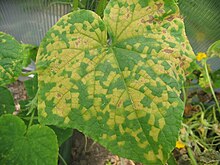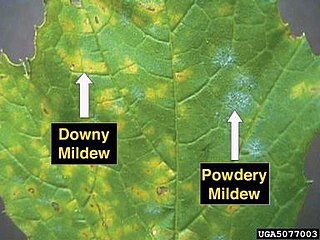
Powdery mildew is a fungal disease that affects a wide range of plants. Powdery mildew diseases are caused by many different species of ascomycete fungi in the order Erysiphales. Powdery mildew is one of the easier plant diseases to identify, as its symptoms are quite distinctive. Infected plants display white powdery spots on the leaves and stems. The lower leaves are the most affected, but the mildew can appear on any above-ground part of the plant. As the disease progresses, the spots get larger and denser as large numbers of asexual spores are formed, and the mildew may spread up and down the length of the plant.

Fusarium wilt is a common vascular wilt fungal disease, exhibiting symptoms similar to Verticillium wilt. This disease has been investigated extensively since the early years of this century. The pathogen that causes Fusarium wilt is Fusarium oxysporum. The species is further divided into formae speciales based on host plant.

Downy mildew refers to any of several types of oomycete microbes that are obligate parasites of plants. Downy mildews exclusively belong to the Peronosporaceae family. In commercial agriculture, they are a particular problem for growers of crucifers, grapes and vegetables that grow on vines. The prime example is Peronospora farinosa featured in NCBI-Taxonomy and HYP3. This pathogen does not produce survival structures in the northern states of the United States, and overwinters as live mildew colonies in Gulf Coast states. It progresses northward with cucurbit production each spring. Yield loss associated with downy mildew is most likely related to soft rots that occur after plant canopies collapse and sunburn occurs on fruit. Cucurbit downy mildew only affects leaves of cucurbit plants.
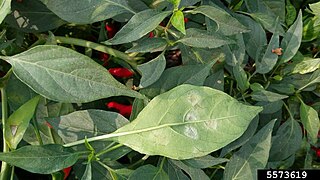
Leveillula taurica is an obligate fungal pathogen, from the phylum Ascomycota, which causes powdery mildew on onion. This disease prefers warm, dry environments. It is rare in the United States, and is currently restricted to western states. Globally, it is also a minor problem with limited occurrences in the Middle East, Europe, and South America. L. taurica causes powdery mildew of onions, but is also known to infect other allium, solanaceous, and cucurbit species. The disease has appeared in parts of the Middle East, the Mediterranean, and South and North America. Currently, it is not a cause for major concern in the U.S. and throughout the world, as its geographic extent is sparse. In addition, it is relatively easy to control through basic sanitation and reducing water stress.
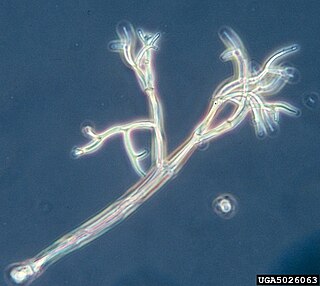
Peronospora sparsa is an oomycete plant pathogen that causes downy mildew in berry producing plants; especially in the genus's Rubus and Rosa. Downy mildew plant pathogens are often host specific and cause problems in cloudberries, blackberries, boysenberries, strawberries, and arctic bramble. Since they are host specific, Peronospora sparsa will not cause downy mildew in grapes because a different plant pathogen causes downy mildew in grapes; Plasmopara viticola. Although it depends on the cultivar, symptoms do not normally start until later stages of disease and can look different on different plants. The most common symptoms include red lesions in the veins of leaves, with dry and deformed berries.
Sclerophthora macrospora is a protist plant pathogen of the class Oomycota. It causes downy mildew on a vast number of cereal crops including oats, rice, maize, and wheat as well as varieties of turf grass. The common names of the diseases associated with Sclerophthora macrospora include "crazy top disease" on maize and yellow tuft disease on turf grass. The disease is present all over the world, but it is especially persistent in Europe.

Podosphaera macularis is a plant pathogen infecting several hosts including chamomile, caneberrie, strawberries, hop, hemp and Cineraria. It causes powdery mildew of hops.

Bremia lactucae is a plant pathogen. This microorganism causes a disease of lettuce denominated as downy mildew. Some other strains can be found on 36 genera of Asteraceae including Senecio and Sonchus. Experiments using sporangia from hosts do not infect lettuce and it is concluded that the fungus exists as a quantity of host-specific strains. Wild species, such as Lactuca serriola, or varieties of Lactuca can hold strains that infect lettuce, but these pathogens are not sufficiently common to seriously infect the plant.

Peronospora farinosa is a species name that has been widely applied to downy mildew on leaves of wild and cultivated Amaranthaceae: Amaranthus, Atriplex, Bassia, Beta, Chenopodium, Halimione, Salsola, Spinacia, etc. However, the species name has been taxonomically rejected as the original description contained reference to multiple species and could not unequivocally be attributed to a species of Peronospora. In the past, some of the species on important crop plants have been given names as formae speciales, notably f.sp. betae on sugar beet and f.sp. spinaciae on spinach. However, phylogentic reconstructions have revealed that these "forms" of Peronospora on different genera and their subdivisions, are distinct species, most of which already have previously published scientific names. Such host specialization possibly also exists with respect to the various wild amaranthaceous species given as hosts of P. farinosa.

Peronospora manshurica is a plant pathogen. It is a widespread disease on the leaves of soybeans and other crop plants. The fungi is commonly referred to as downy mildew, "leafspot", or "leaf-spot".
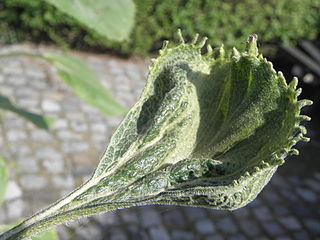
Plasmopara halstedii is a plant pathogen infecting sunflowers. The species is one of many pathogens commonly referred to as downy mildew. P. halstedii originated in North America.
Pseudoperonospora cannabina is a plant pathogen that causes downy mildew, which is a fungal-like disease caused by an oomycete.

Phytophthora capsici is an oomycete plant pathogen that causes blight and fruit rot of peppers and other important commercial crops. It was first described by L. Leonian at the New Mexico State University Agricultural Experiment Station in Las Cruces in 1922 on a crop of chili peppers. In 1967, a study by M. M. Satour and E. E. Butler found 45 species of cultivated plants and weeds susceptible to P. capsici In Greek, Phytophthora capsici means "plant destroyer of capsicums". P. capsici has a wide range of hosts including members of the families Solanaceae and Cucurbitaceae as well as Fabaceae.
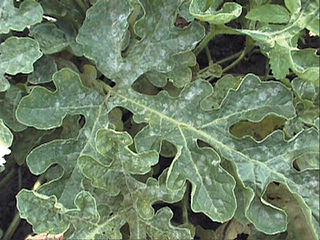
Podosphaera fuliginea is a plant pathogen that causes powdery mildew on cucurbits. Podosphaera fuliginea and Erysiphe cichoracearum are the two most commonly recorded fungi causing cucurbit powdery mildew. In the past, Erysiphe cichoracearum was considered to be the primary causal organism throughout most of the world. Today, Podosphaera fuliginea is more commonly reported.

Didymella bryoniae, syn. Mycosphaerella melonis, is an ascomycete fungal plant pathogen that causes gummy stem blight on the family Cucurbitaceae, which includes cantaloupe, cucumber, muskmelon and watermelon plants. The anamorph/asexual stage for this fungus is called Phoma cucurbitacearum. When this pathogen infects the fruit of cucurbits it is called black rot.
Peronosclerospora sorghi is a plant pathogen. It is the causal agent of sorghum downy mildew. The pathogen is a fungal-like protist in the oomycota, or water mold, class. Peronosclerospora sorghi infects susceptible plants though sexual oospores, which survive in the soil, and asexual sporangia which are disseminated by wind. Symptoms of sorghum downy mildew include chlorosis, shredding of leaves, and death. Peronosclerospora sorghi infects maize and sorghum around the world, but causes the most severe yield reductions in Africa. The disease is controlled mainly through genetic resistance, chemical control, crop rotation, and strategic timing of planting.

Melothria scabra, commonly known as the cucamelon, Mexican miniature watermelon, Mexican sour cucumber, Mexican sour gherkin, mouse melon, or pepquinos, is a species of flowering plant in the cucurbit family grown for its edible fruit. Its native range spans Mexico to Venezuela. Cucumis melo Agrestis and Cucumis callosus is cultivated as Chibber Fruit or Kachri in South Asia and can also grow as weed. Fruits are about the size of grapes and taste like cucumbers with a tinge of sourness. It may have been eaten by indigenous peoples before the European colonization of the Americas began.
This article summarizes different crops, what common fungal problems they have, and how fungicide should be used in order to mitigate damage and crop loss. This page also covers how specific fungal infections affect crops present in the United States.

Peronospora destructor is a plant pathogen. It causes downy mildew on leaves of cultivated and wild Allium. Allium cepa is most often affected, while Allium schoenoprasum (chives) and Allium porrum (leek) are only occasionally affected.
Gummy stem blight is a cucurbit-rot disease caused by the fungal plant pathogen Didymella bryoniae. Gummy stem blight can affect a host at any stage of growth in its development and affects all parts of the host including leaves, stems and fruits. Symptoms generally consist of circular dark tan lesions that blight the leaf, water soaked leaves, stem cankers, and gummy brown ooze that exudes from cankers, giving it the name gummy stem blight. Gummy stem blight reduces yields of edible cucurbits by devastating the vines and leaves and rotting the fruits. There are various methods to control gummy stem blight, including use of treated seed, crop rotation, using preventative fungicides, eradication of diseased material, and deep plowing previous debris.
